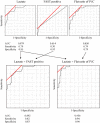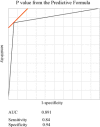A simple predictive formula for the blood requirement in patients with high-energy blunt injuries transferred within one hour post-trauma
- PMID: 29123699
- PMCID: PMC5667202
- DOI: 10.1002/ams2.74
A simple predictive formula for the blood requirement in patients with high-energy blunt injuries transferred within one hour post-trauma
Abstract
Aims: To recognize patients who require massive transfusion at the early stage of blunt trauma, we retrospectively investigated patients with high-energy blunt injuries transferred within 1 h post-trauma.
Methods: Between August 2007 and July 2011, 233 trauma patients were: (i) injured by a high-energy blunt mechanism with Injury Severity Score ≥9; (ii) not dead on arrival; (iii) older than 9 years; and (iv) at our center within 1 h after injury. The findings for 113 of those patients were analyzed, including those produced by ultrasonography, computed tomography, and arterial blood gas analyses.
Results: Of 113 patients, 33 underwent massive transfusion (≥6 units) within 8 h of arrival. A logistic regression analysis revealed that an arterial lactate level ≥28 mg/dL (P < 0.001; odds ratio, 105.11; 95% confidence interval, 12.58-2,718.84) and a flat ratio of the inferior vena cava on computed tomography ≥3 (P < 0.001; odds ratio, 32.50; 95% confidence interval, 4.44-714.44) were significant independent predictors for a massive transfusion within 8 h. In a receiver operating curve analysis, the area under the curve of the need for massive transfusion was 0.956, with a sensitivity of 0.94 and a specificity of 0.90. A linear predictive formula for the probability (P) of receiving a massive transfusion was generated as P = 2 × lactate (mg/dL) + 15 × the flat ratio of inferior vena cava - 103. Using another 52 trauma patients, the formula was validated.
Conclusions: An elevated level of arterial lactate and the flat ratio of inferior vena cava were significant predictors for identifying the patients who would require a massive transfusion in the early stage after high-energy blunt trauma.
Keywords: Arterial blood gases; flat ratio; inferior vena cava; lactate; massive transfusion; trauma.
Figures


References
-
- Kortbeek JB, Al Turki SA, Ali J et al Advanced trauma life support, 8th edition, the evidence for change. J. Trauma 2008; 64: 1638–1650. - PubMed
-
- McLaughlin DF, Niles SE, Salinas J et al A predictive model for massive transfusion in combat casualty patients. J. Trauma 2008; 64 (2 Suppl.): S57–63. - PubMed
-
- Yucel N, Lefering R, Maegele M et al Trauma Associated Severe Hemorrhage (TASH) Score: probability of mass transfusion as surrogate for life threatening hemorrhage after multiple trauma. J. Trauma 2006; 60: 1228–1236. - PubMed
-
- Japan Trauma Care and Research . Japan trauma data bank report 2011 (2006–2010). 2011. [cited 15 Dec 2011].
-
- Callcut RA, Johannigman JA, Kadon KS, Hanseman DJ, Robinson BR. All massive transfusion criteria are not created equal: defining the predictive value of individual transfusion triggers to better determine who benefits from blood. J. Trauma 2011; 70: 794–801. - PubMed
LinkOut - more resources
Full Text Sources
Other Literature Sources

